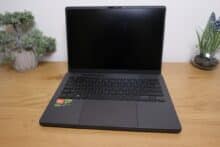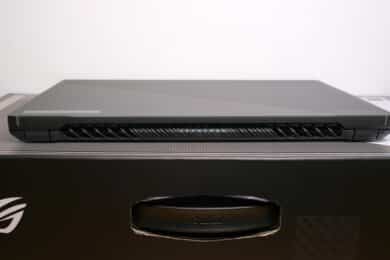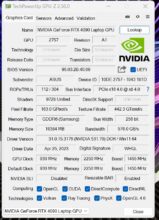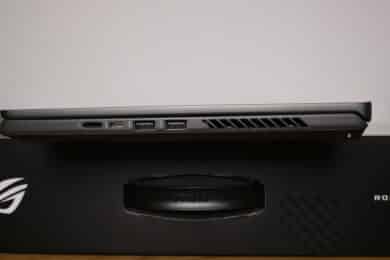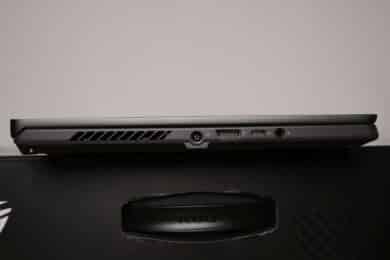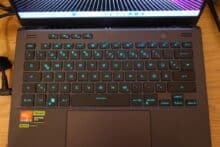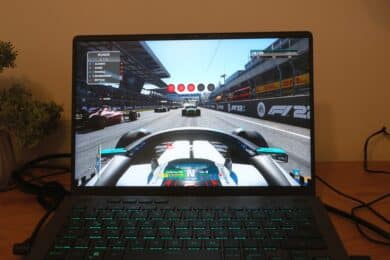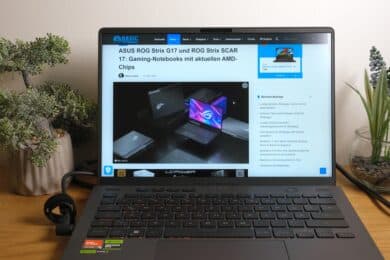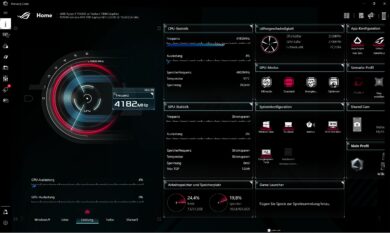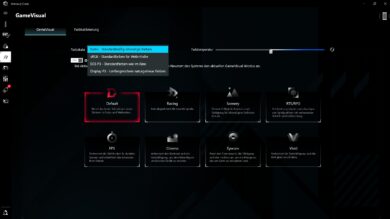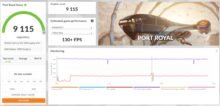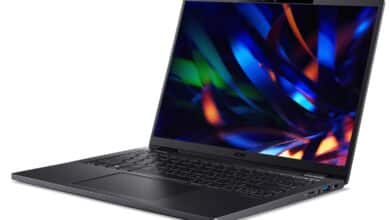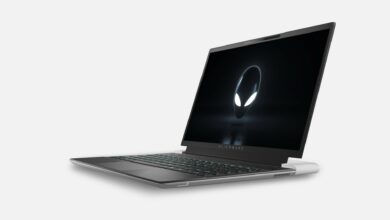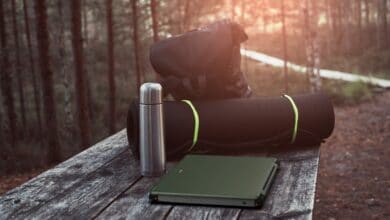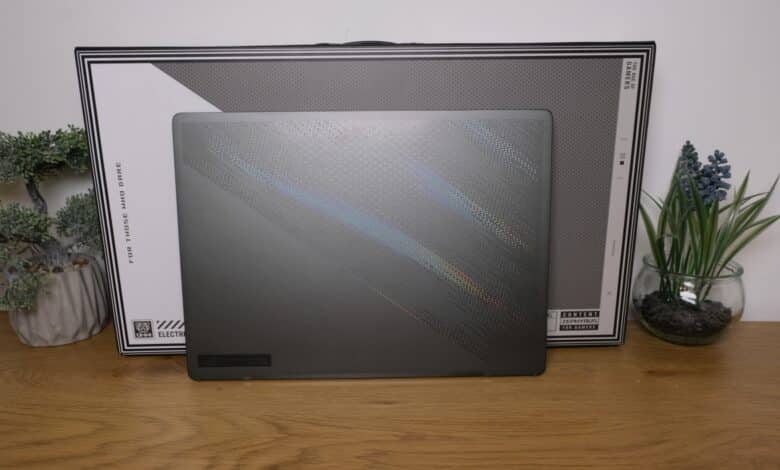
Gaming laptops are usually bulky and heavy. The trend this year is toward 17- or even 18-inch notebooks anyway – but where are the compact laptops that were still around last year? It seems as if the manufacturer ASUS is almost alone in the field. The popular 14-inch model has been relaunched. And this year, the GA402 variant is equipped with a very strong configuration. A total package that inspires, as our ASUS ROG Zephyrus G14 review proves.
Technical data
| Processor | AMD Ryzen 9 7940HS (8 cores, 4.0 – 5.2 GHz) |
| Graphics performance | Nvidia GeForce RTX 4090 (16GB GDDR6 VRAM); 125 W TDP |
| Display | 14 inch; QHD+; 165 Hz |
| Storage | 1 TB SSD (NVMe PCIe 4.0) installed |
| Memory | 32 GB DDR5 RAM (16 GB DDR5-4800 SO-DIMM + 16 GB soldered) |
| Keyboard | Compact; chiclet; with RGB lighting |
| Operating system | Windows 11 Pro |
| Connectivity | Wi-Fi 6E; Bluetooth 5.3 |
| Dimensions (W x D x H) | 312 mm x 226.5 mm x 20.5 mm |
| Weight | 1.693 kg (without power supply) |
| Price | € 3,499.00 * |

ASUS ROG Zephyrus G14 review: design and build
- Simple yet chic design
- Fingerprints don’t stand a chance
- Hinge lifts notebook slightly; impeccable workmanship
The ASUS ROG Zephyrus G14 is a sleek gaming notebook. Not much has changed in the case compared to the direct predecessor. Our test model relies on a dark gray color scheme (called Eclipse Grey), which is not very susceptible to fingerprints and looks very classy with the anodized finish. The gaming notebook weighs in at 1,693 grams.
Similar to the ROG Zephyrus M16 (our review), the display lid relies on a perforated pattern for a bit more than 50%, but in contrast to the aforementioned notebook, the G14 manages without the AniMe matrix display on the lid, which shows system information, animations or similar. However, that is also available as an option, if you want it.
But back to the simple design: On the lid, there is only the reflective “Republic of Gamers” print, which, together with the “Zephyrus” lettering on the back of the laptop, is the only indication of the power slumbering under the hood.
Air vents and inlets extend almost the entire bottom of the G14 and are found on both sides, as well as the back, which bodes well for effective cooling. At the bottom, you’ll find two rubberized feet across the entire width, while you can access the interior with Phillips screws for maintenance.
The build quality of the G14 is also on an excellent level: the magnesium alloy chassis looks extremely sturdy and high quality, and doesn’t give in under pressure.
Another practical feature is the sturdy and ergonomic hinge, which lifts the notebook slightly when open, allowing for better airflow. At the same time, the notebook can be opened by a whopping 180 degrees and thus placed completely flat on a surface.
Features and ports
- top-modern high-end equipment
- 16 GB RAM soldered only
- Fast standards; good webcam; very good speakers
Compared to the already mentioned M16, the ASUS ROG Zephyrus G14 relies on a cutting-edge AMD CPU. Instead of the Intel Core i9-13900H with 14 cores and clock rates of up to 5.4 GHz, the manufacturer relies on the Zen 4 powerhouse AMD Ryzen 9 7940HS for this notebook, which comes up with 8 cores and clock rates of up to 5.2 GHz.
However, the AMD CPU is already clocked higher in the base unit: 4.0 GHz compared to 1.9 GHz for Intel – so a comparison will be very exciting.
The processor is supported by NVIDIA’s GeForce RTX 4090, which is the current top GPU model with 16 GB VRAM and a maximum TGP of 125 watts in Turbo mode (100 watts TGP + 25 watts Dynamic Boost).
The iGPU Radeon 780M is used in desktop mode or in light applications, which is replaced by the stronger dedicated graphics card via NVIDIA Advanced Optimus when games are started.
ASUS also gives the G14 a whopping 32 GB of DDR5-4800 RAM. 16 GB of it are permanently installed on the motherboard, the other half is available as SO-DIMM and can be expanded accordingly. A maximum of 32 GB can be installed, so you can get a total of 48 GB RAM.
The same applies to the 1 TB PCIe 4.0 M.2 SSD, which can also be replaced and expanded. In addition, there is fast WI-FI 6E with excellent speeds and impeccable stability, modern Bluetooth 5.3 and a 1080p IR webcam with good image quality.

For acoustics, four speakers with Hi-Res certification and Smart Amp technology are used, which support Dolby Atmos. They actually achieve detailed, rich sound with excellent volume.
What ports does the ASUS ROG Zephyrus G14 offer?
- Excellent selection of ports
The problem with a compact notebook: there is correspondingly less space available for ports. Normally, anyway, because for the ASUS ROG Zephyrus G14 this is only conditionally true.
On the left side, we find HDMI 2.1, USB-C with USB 4.0 (including DisplayPort legacy mode and Power Delivery) and a 3.5 mm jack. On the right, there is a microSD card reader, USB-C 3.2 Gen.2 (also with DisplayPort legacy mode) and two USB-A 3.2 Gen.2 ports.
Excellent, we have seen much less choice even in larger notebooks like the HP Omen 17 (2023).
Keyboard and touchpad
- Good keyboard
- Very good, large touchpad
The ASUS ROG Zephyrus G14 relies on a chiclet keyboard with a key travel of around 1.6 mm, although it would have to be compressed a bit due to the compact case. The typing feel is definitely convincing even for longer texts – only the unusual layout takes some getting used to.
Nevertheless, the typing feel is quite convincing. The same applies to the generous 7.8 cm x 12.8 cm (height x width) glass touchpad, which has excellent gliding properties and also implements gestures very well and convinces with a pleasant clicking noise.
While most will switch to an external gaming keyboard and mouse for gaming anyway, the keyboard and touchpad are great for on-the-go or occasional typing. Colorful and customizable RGB lighting is also provided, of course.
Display: Mini LED panel with 165 Hz
- Fast, high-resolution display
- Convincing brightness and color space coverage
For the display, ASUS relies on a ROG Nebula mini LED display with a QHD+ resolution of 2,560 x 1,600 pixels and a refresh rate of 165 Hz. Unlike the ROG Nebula HDR display of the Zephyrus M16, the panel here peaks at “only” around 500 nits of brightness (as opposed to over 1,000 nits for the HDR counterpart).
However, that is still an excellent value, which provides almost infinite contrasts especially in combination with the mini-LED technology. The DCI-P3 color space is also fully covered by 100 percent, which should also be interesting for creative professionals.
In the standard profile, however, the colors look a bit too strong for our taste. You can counteract this in the Armoury Crate companion software. Here you can choose from different picture profiles, as well as modes for different genres, while a color calibration of the display is also offered.
All in all, this is a really excellent and fast display that makes gaming and consuming content fun.
Practical test of the ASUS ROG Zephyrus G14
- First-rate performance in all areas
- Very many background processes active
The practical test of the ASUS ROG Zephyrus G14 went as expected. Thanks to the excellent performance, the notebook copes excellently with demanding tasks, multi-tasking and modern, as well as demanding games.
A few things still struck me, though. On the one hand, as is typical for ASUS, quite a few apps and programs are constantly running in the background (which you can of course counteract manually if you know your way around a bit).
105 background processes after booting – without installing or starting any software – is quite a number. This doesn’t affect the performance noticeably, but a certain amount of memory is always occupied.
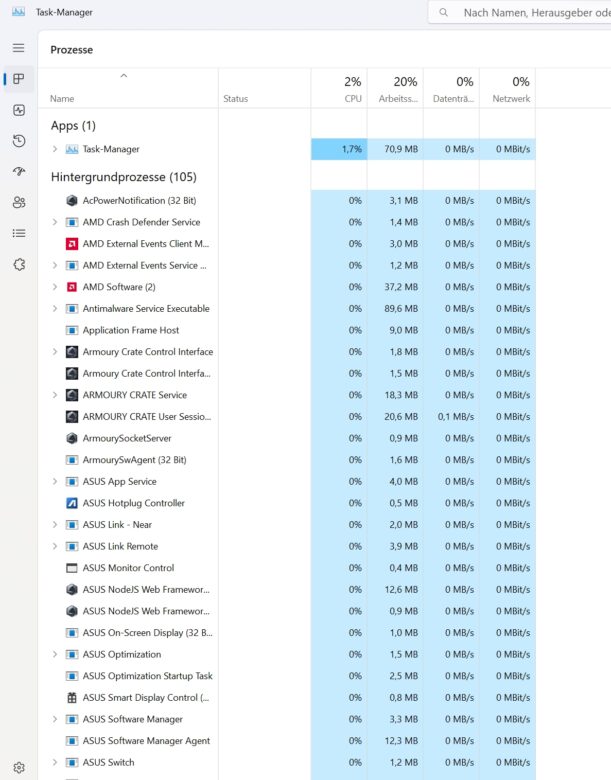
Another problem: For some unknown reason, I could not start the open-world racing game Forza Horizon 5 during my ASUS ROG Zephyrus G14 test. Despite multiple reinstallations, all driver and software updates and checks, the game simply refused to work.
High fan noise in the G14
- Up to 56 dB(A) in games
- Excellent, effective cooling
On the other hand, there are positive things to report about the cooling, which really cools down the notebook impeccably. Even m stress test under continuous load, the laptop gets warm on the underside, but not excessively hot. You can even play on your lap without any problems.
However, the G14 can get quite loud – depending on the selected performance mode, which you can set in the Armoury Crate companion software. Not only can you squeeze a bit more power out of the gaming notebook, but you can also activate the “Quiet” profile, which is especially useful for less demanding, everyday tasks.
Here, the device does not get louder than about 40 dB(A) even in games and even remains completely silent in most cases. In the standard enabled performance profile, it can get quite loud with a peak of up to 56 dB(A), but that is also within the normal range for a gaming notebook.
The M16 from ASUS, for example, is not quite as loud with 48 dB(A), but it also has a much bigger case with better cooling.
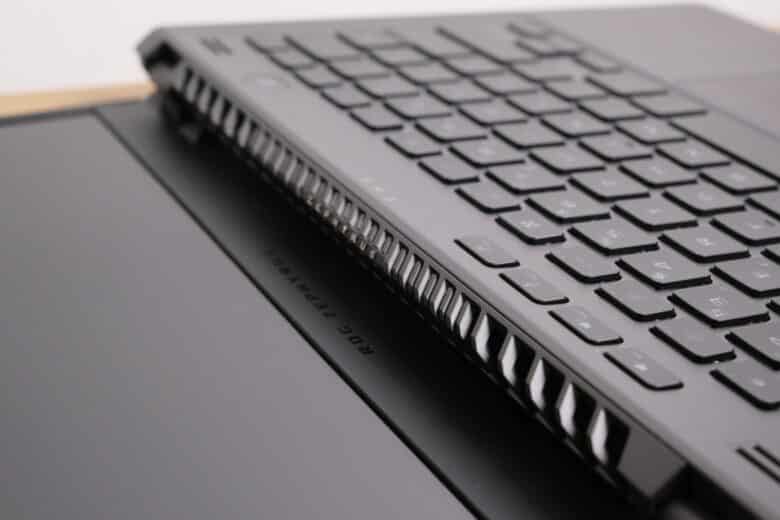
Still, as a very personal conclusion, I would prefer the ASUS ROG Zephyrus G14. Because I personally appreciate the mobility aspect of a small, quite light notebook much more. Thus, I have an excellent performance on the go or on the sofa, while I can access the maximum power at my desk with external peripherals and monitor. Always a shame that there aren’t more gaming notebooks in the 14-inch range.
Benchmark: Productivity, System, SSD and Gaming
But just how much performance lies dormant in the ASUS ROG Zephyrus G14? And what does the AMD Ryzen 7000 CPU have up its sleeve? I was very curious about that, which is why I put the gaming notebook through a whole series of tests.
I measured the productivity and system performance with PCMark 10 and Cinebench R23. PCMark 10 simulates different workflows that include word processing, web browsing and spreadsheets when running the benchmark. Cinebench, on the other hand, measures the speed of the CPU cores individually as well as in multi-core mode.
For the gaming tests, we use the synthetic benchmark 3DMark as well as various games like F1 22 including ray tracing, Final Fantasy XV and many more. For better comparability, I mainly performed the tests in Full HD resolution, but also looked at how much power is still possible with the maximum resolution.
Furthermore, the default activated profile “Performance” was used in the tests. If you select the “Turbo” profile in Armoury Crate, you can squeeze out a few more FPS.
SSD benchmark
ASUS once again relies on Samsung for the SSD and installs the PM9A1, the OEM version of the 980 Pro, which scores accordingly with a very good performance. The PCIe 4.0 SSD also maintains the performance in the long run and scores with the 4K-64-Thrd performance, as well as with sequential reads and writes.
Cinebench R23 and PCMark 10
- Ryzen 9 keeps up with Intel’s top CPUs
- Even faster in system performance and creative apps
The system performance of the G14 is also convincing across the board. In fact, the installed Zen 4 processor AMD Ryzen 9 7940HS achieves an excellent performance in the multi- and single-core test, but cannot quite keep up with the Intel Core i9-13900H in both, which is used in the ROG Zephyrus M16, for example. Not to mention the 13900HX in the HP Omen 17 2023.
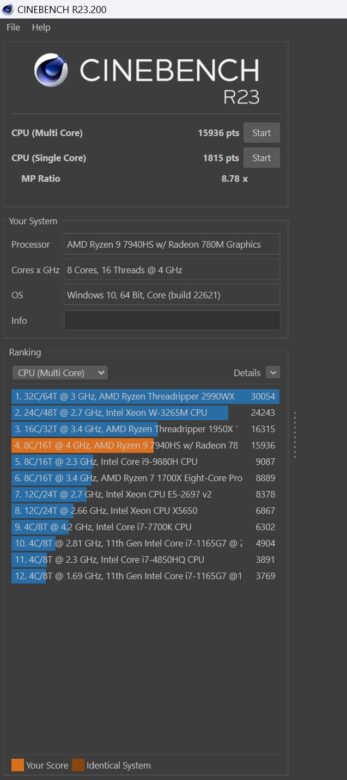
However, you also have to keep in mind that both Intel CPUs allow themselves significantly more performance than the efficient AMD model. The performance gap that you have to accept for this turns out comparatively low and is hardly noticeable in practice anyway.

The PCMark benchmark shows how efficient and fast the Ryzen 9 really is. AMD’s top model outperforms the aforementioned Intel Core chips in almost all areas. In the end, a total score of 8,203 points is achieved – the new top score of all notebooks we have tested so far.
| Benchmark | G14 | M16 | Omen 17 |
| Cinebench Multi | 15,936 pts | 18,811 pts. | 18,302 pts. |
| Cinebench Single | 1,815 pts | 2,027 pts. | 2,102 pts. |
| PCMark Total | 8,203 pts | 7,900 pts. | 7,946 pts. |
| PCMark Essentials | 10,406 pts | 11,883 pts. | 11,417 pts. |
| PCMark product. | 10,993 pts. | 9,659 pts. | 11,526 pts. |
| PCMark Digital CC | 13,097 pts | 11,658 pts. | 10,348 pts. |
Graphics performance: 3D mark and gaming tests
- First-class gaming performance in 1080p and QHD+
- No performance loss even over time
With a maximum TDP of 125 watts – including Dynamic Boost – the installed RTX 4090 is weaker on paper than the same model in the ROG Zephyrus M16 and has a whole 50 watts less power available than the RTX 4080 in the Omen 17. Nevertheless, the 3D and gaming performance can fully convince in my eyes.
The ASUS ROG Zephyrus G14 is slightly behind in the synthetic benchmarks, but the compact 14-incher easily makes up for that in the real gaming tests and places itself between the two mentioned notebooks. Even demanding, modern games including maximum ray tracing settings, such as F1 22, are easily mastered by the laptop and approach the 100 FPS mark.
At the maximum resolution of 2,560 x 1,600 pixels, the frame rate drops noticeably depending on the game (58 FPS versus 92 FPS in F1 22; 143 FPS versus 159 FPS), but enough reserves are still available.
| Benchmark | G14 | M16 | Omen 17 |
| Fire Strike Total | 30,062 pts | 31,026 pts. | 27,526 pts. |
| Time Spy total | 13,061 pts. | 14,418 pts. | 14,927 pts. |
| Port Royal total | 9,115 pts. | 9,871 pts. | 10,023 pts. |
| Speed Way Total | 3,774 pts | 3,867 pts. | 4,358 pts. |
| F1 22 | 92 FPS | 88 FPS | 97 FPS |
| FF XV | 13,726 pts | 13,447 pts. | 14,746 pts. |
| Shadow o.t. Tomb Raider | 159 FPS | 113 FPS | 175 FPS |
It is also positively noticeable that the notebook can also maintain this performance in the long run despite its compact design. In the speed-way stress test, 97.8 percent stability is recorded. Outstanding.
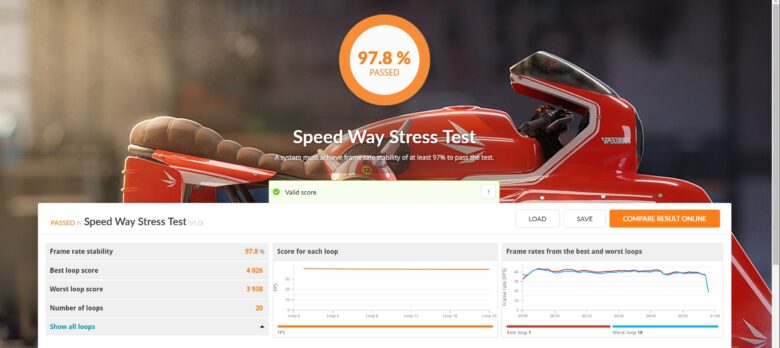
Battery life of the ASUS ROG Zephyrus G14
- 76 Wh battery capacity
- About 4 hours of runtime at maximum brightness
76 watt-hours is the capacity of the built-in battery and as always with a gaming notebook, the runtimes turn out to be manageable. Around 4 hours at maximum brightness in the idle test of PCMark 10 is reached in the end. But hey: At least more than the M16 or Omen 17.
The ASUS ROG Zephyrus G14 also ends up ahead of the two competitors in the gaming benchmark with a runtime of around 90 minutes. Of course, this value is rather theoretical because only a fraction of the performance is available in battery mode due to the very limited power limits.
ASUS ROG Zephyrus G14 review: Conclusion
With the ASUS ROG Zephyrus G14, the manufacturer has hit the big time in my eyes. Apart from the fact that I am a fan of smaller and correspondingly more mobile gaming notebooks anyway, the laptop also has a lot of steam under the hood.
So much, in fact, that the gaming and system performance in creative applications even surpasses the competition we have tested so far. The Ryzen 9 is both powerful and efficient and can almost keep up with Intel’s top Core i9 models.
In conjunction with the efficient cooling, the performance is also maintained over time, while the display also leaves a very good impression – although it cannot quite keep up with the in-house Nebula HDR counterpart in terms of brightness.
In my opinion, however, points are deducted for the at least half-soldered RAM and the enormous number of constantly active background processes. Apart from that, the ASUS ROG Zephyrus G14 is an outstanding gaming notebook in the absolute high-end segment, but its price seems comparatively fair compared to the competition in view of the offered performance.
ASUS ROG Zephyrus G14
Design & workmanship
Display
Features
Performance
Battery
Value for money
94/100
Brutal performance, efficient cooling and a compact chassis: The ASUS ROG Zephyrus G14 impressively proves what a 14-inch gaming notebook can do. Outstanding.



